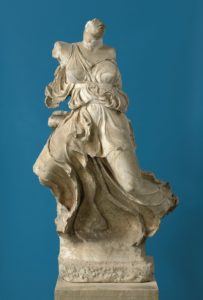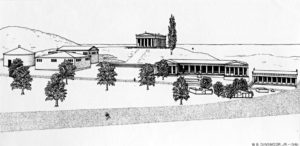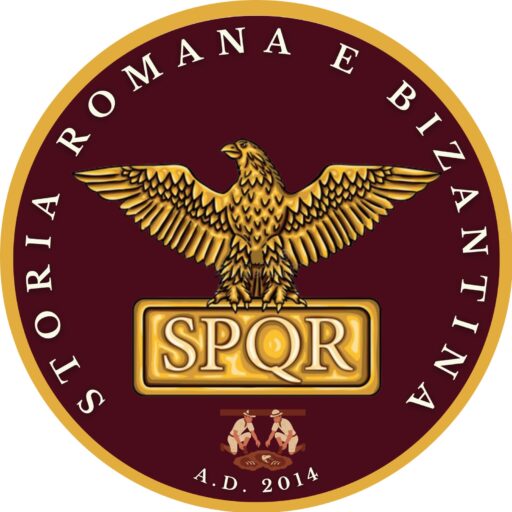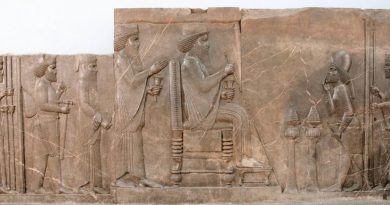Stoà di Zeus Eleutherios
 La stoà di Zeus Eleutherios era situata nell’angolo nord-occidentale dell’agorà di Atene, a sud della stoà basileia. Il nome Eleutherios deriva da eleuteria che significa libertà.
La stoà di Zeus Eleutherios era situata nell’angolo nord-occidentale dell’agorà di Atene, a sud della stoà basileia. Il nome Eleutherios deriva da eleuteria che significa libertà.
E’ un edificio che si data al 430-420 a.C. ed è attribuito all’architetto Mnesicle. Pausania (I, 3, 1), scrive che entrando nell’agorà il primo edificio a destra è la stoà regale seguita dalla stoà di Zeus Eleutherios costruita sulle rovine del precedente tempietto di VI Secolo a.C. in continuità del culto.
The district of the Cerameicus has its name from the hero Ceramus, he too being the reputed son of Dionysus and Ariadne. First on the right is what is called the Royal Portico, where sits the king when holding the yearly office called the kingship. On the tiling of this portico are images of baked earthenware, Theseus throwing Sciron into the sea and Day carrying away Cephalus, who they say was very beautiful and was ravished by Day, who was in love with him. His son was Phaethon,<afterwards ravished by Aphrodite>. . . and made a guardian of her temple. Such is the tale told by Hesiod, among others, in his poem on women.
Pausania, I, 3, 1 description of Greece

 Attualmente, per il suo stato di conservazione, l’edificio è di difficile lettura ma doveva presentarsi come una stoà elegante con dimensioni considerevoli di 47m di lunghezza e 18m di altezza con doppio colonnato in ordine dorico esterno e ordine ionico interno. Il tetto doveva essere decorato con due statue acroteriali raffiguranti Nikai, le divinità della vittoria e di cui una è stata ritrovata quasi intera. Lungo le mura esterne vi dovevano essere altre statue raffiguranti Conone con il figlio Timoteo, Evagora I re di Cipro, Zeus Eleutherios e l’imperatore Adriano delle quali restano soltanto le basi.
Attualmente, per il suo stato di conservazione, l’edificio è di difficile lettura ma doveva presentarsi come una stoà elegante con dimensioni considerevoli di 47m di lunghezza e 18m di altezza con doppio colonnato in ordine dorico esterno e ordine ionico interno. Il tetto doveva essere decorato con due statue acroteriali raffiguranti Nikai, le divinità della vittoria e di cui una è stata ritrovata quasi intera. Lungo le mura esterne vi dovevano essere altre statue raffiguranti Conone con il figlio Timoteo, Evagora I re di Cipro, Zeus Eleutherios e l’imperatore Adriano delle quali restano soltanto le basi.
Near the portico stand Conon, Timotheus his son and Evagoras¹ King of Cyprus, who caused the Phoenician men-of-war to be given to Conon by King Artaxerxes. This he did as an Athenian whose ancestry connected him with Salamis, for he traced his pedigree back to Teucer and the daughter of Cinyras. Here stands Zeus, called Zeus of Freedom, and the Emperor Hadrian, a benefactor to all his subjects and especially to the city of the Athenians.
¹ Evagoras was a king of Salamis in Cyprus, who reigned from about 410 to 374 B.C. He favoured the Athenians, and helped Conon to defeat the Spartan fleet off Cnidus in 394 B.C.Pausania, I, 3, 2 description of Greece
All’interno della stoà di Zeus Eleutherios vi erano lungo le pareti pitture, opere di Eufranore, ad abbellire come descritto sempre da Pausania e che raffiguravano la battaglia di Mantinea (uno scontro tra le cavallerie degli Ateniesi e dei Tebani), i Dodici dei, e Teseo con le personificazioni del Demos (popolo) e della Democrazia.
A portico is built behind with pictures of the gods called the Twelve. On the wall opposite are painted Theseus, Democracy and Demos. The picture represents Theseus as the one who gave the Athenians political equality. By other means also has the report spread among men that Theseus bestowed sovereignty upon the people, and that from his time they continued under a democratical government, until Peisistratus rose up and became despot.¹ But there are many false beliefs current among the mass of mankind, since they are ignorant of historical science and consider trustworthy whatever they have heard from childhood in choruses and tragedies; one of these is about Theseus, who in fact himself became king, and afterwards, when Menestheus was dead, the descendants of Theseus remained rulers even to the fourth generation. But if I cared about tracing the pedigree I should have included in the list, besides these, the kings from Melanthus to Cleidicus the son of Aesimides.¹ 560-527 B.C.
Pausania, I, 3,2 description of Greece
Infine, Pausania ricorda che vi erano degli scudi appartenuti ad ateniesi morti in difesa della città: uno morto in uno scontro contro i Macedoni e un altro morto contro i Galli/Galati.
Here is built also a sanctuary of the Mother of the gods; the image is by Pheidias¹. Hard by is the council chamber of those called the Five Hundred, who are the Athenian councillors for a year. In it are a wooden figure of Zeus Counsellor and an Apollo, the work of Peisias,² and a Demos by Lyson. The thesmothetae (lawgivers) were painted by Protogenes³ the Caunian, and Olbiades¹′ portrayed Callippus, who led the Athenians to Thermopylae to stop the incursion of the Gauls into Greece.²′
¹ 490-432 B.C.
² The dates of these artists are unknown.
³ A contemporary of Alexander the Great.
¹′ An unknown painter.
²′ 279 B.C.
Pausania, I, 3, 5 description of Greece
 Davanti alla stoà di Zeus Eleutherios venne eretta una grande statua di Zeus, e dagli scavi è venuta fuori una grande base circolare. Non sappiamo moltissimo sull’uso della stoà, naturalmente ci passeggiavano ed era la preferita da Socrate. Venne costruita per dare un assetto architettonico migliore alla zona dell’agorà. Doveva avere anche funzione religiosa relativa al culto di Zeus e siccome era posta vicino alla sede dell’arconte re dovevano svolgere anche funzioni amministrative della città, forse sede dei Tesmoteti, ma è solo un’ipotesi.
Davanti alla stoà di Zeus Eleutherios venne eretta una grande statua di Zeus, e dagli scavi è venuta fuori una grande base circolare. Non sappiamo moltissimo sull’uso della stoà, naturalmente ci passeggiavano ed era la preferita da Socrate. Venne costruita per dare un assetto architettonico migliore alla zona dell’agorà. Doveva avere anche funzione religiosa relativa al culto di Zeus e siccome era posta vicino alla sede dell’arconte re dovevano svolgere anche funzioni amministrative della città, forse sede dei Tesmoteti, ma è solo un’ipotesi.




